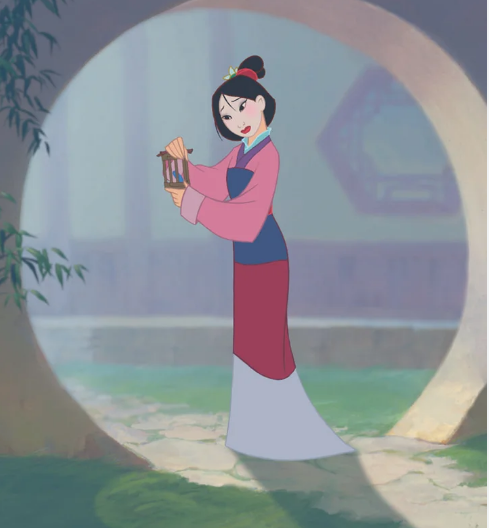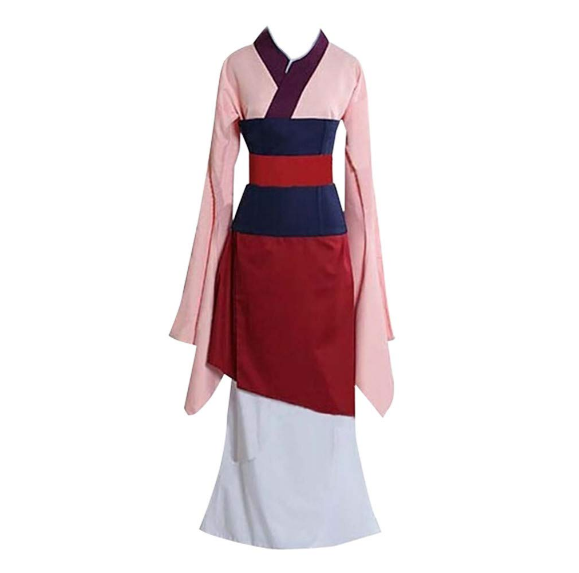Yes, Mulan wore a type of hanfu known as “Qiyao Ruqun/齐腰襦裙” or “Waist-high Ruqun” when not in battle.
Mulan Historical Context
The legend of Mulan, deeply rooted in Chinese history, narrates the story of a courageous woman who disguised herself as a man to serve in the military, replacing her ailing father. This tale, originating from a folk song in the Northern Wei dynasty, later transcribed in the “Ballad of Mulan,” resonates with themes of filial piety and bravery. Notably, the historical accuracy of Mulan’s existence remains a topic of debate among scholars, with some suggesting her story blends historical events and mythical elements.
Origin of the Mulan Legend
The earliest known version of the Mulan story appears in the “Ballad of Mulan,” a narrative poem from the 6th century. This ballad, lacking detailed descriptions of Mulan’s attire, focuses more on her heroism and sacrifice. Subsequent adaptations, including the Ming dynasty’s “Sui Tang Romance,” further embellished Mulan’s tale, although her clothing remains less emphasized in these accounts.

Clothing in Ancient China
In Mulan’s era, clothing in China underwent significant changes due to dynastic transitions and cultural exchanges. Hanfu, the traditional attire during the Han dynasty, symbolizes Chinese cultural identity. This clothing, characterized by its cross-collar, wide sleeves, and flowing robes, was typical in Mulan’s purported time. However, specifics like fabric quality or color varied based on social status and occasion.
The Role of Hanfu in Chinese Culture
Hanfu, more than just clothing, represents a deep cultural heritage in China. It signifies social status, cultural identity, and aesthetic values of the Chinese people. Over centuries, Hanfu evolved in style, reflecting changes in societal norms and aesthetic preferences. In modern times, there’s been a resurgence of interest in Hanfu, with enthusiasts seeking to reconnect with their cultural roots. This renewed interest also sparks discussions on historical accuracy and cultural representation in media portrayals of historical figures like Mulan.
Understanding Hanfu
Hanfu, the traditional attire of the Han Chinese, embodies a rich historical and cultural legacy. This attire, originating in the Han Dynasty (206 BCE – 220 CE), has evolved over millennia, reflecting China’s cultural and aesthetic values. Hanfu is not just clothing; it represents a profound connection to Chinese heritage and identity.
Definition and History of Hanfu
Hanfu traditionally consists of a robe or a shirt and a skirt, often accompanied by a belt at the waist. Key features include cross collars, wide sleeves, and flowing skirts. The garment’s evolution aligns closely with China’s dynastic history, each era introducing unique styles and modifications. Notably, during the Tang dynasty, Hanfu saw a significant transformation with vibrant colors and luxurious fabrics, indicating the period’s prosperity and openness to foreign influences.
Variations and Styles of Hanfu
Hanfu varies greatly in style, color, and decoration, influenced by factors like dynasty, region, and occasion. For instance, the Shenyi, a type of Hanfu, integrates the upper garment and the lower skirt into a single piece, symbolizing unity and modesty. The colors used in Hanfu often had symbolic meanings; for example, black represented water in the Wu Xing system and was considered a neutral color. Embroideries and patterns on Hanfu, ranging from simple to intricate, often depict symbolic elements like dragons, phoenixes, and floral motifs, each with distinct cultural connotations.
Hanfu in Military and Civilian Life
In military life, Hanfu served practical and symbolic purposes. Soldiers often wore simpler, more robust versions for ease of movement and durability in combat. In contrast, civilian Hanfu ranged from simple garments for everyday wear to elaborate, luxurious attire for the nobility and royalty. The choice of fabric, color, and style in civilian Hanfu reflected one’s social status and wealth. For instance, silk, a highly valued material, was predominantly used by the upper classes.
Mulan Attire in Historical Accounts
In historical accounts, Mulan’s attire reflects the practical needs of a soldier rather than the elaborate styles typical of civilian Hanfu. Ancient texts, focusing on her valor and filial piety, often omit detailed descriptions of her clothing. This omission suggests that her attire, while important, was not the focal point of her legend.
Depictions of Mulan in Ancient Texts
“The Ballad of Mulan,” the earliest known source of her story, provides limited information about her clothing. It briefly mentions her transition from female to male attire in preparation for war, symbolizing her commitment and sacrifice. Later adaptations, like the “Sui Tang Romance,” hint at her wearing typical male military attire of the era, which would have been simpler and more utilitarian compared to the ornate Hanfu of high-ranking officials or royalty. These texts emphasize her role as a warrior and a daughter, rather than as a fashion icon.
Hanfu in Military Context
In the military context of Mulan’s era, Hanfu would have been adapted for practicality and ease of movement. Soldiers, including Mulan, likely wore durable fabrics that could withstand the rigors of battle. Typical military Hanfu might have included shorter tunics and trousers under a light armor for mobility. The focus on functionality over style in military attire reflects the pragmatic approach of ancient Chinese warfare, where efficiency and comfort were paramount for soldiers.
Comparisons with Other Historical Figures’ Attire
Comparing Mulan’s likely military attire with that of contemporary historical figures highlights significant differences in ancient Chinese society’s fashion norms. For instance, while emperors and high-ranking officials adorned themselves with luxurious silks, intricate embroideries, and vibrant colors, symbolizing their status and wealth, the military attire was markedly different. Soldiers’ clothing was more about utility and less about display. This contrast not only reflects the social hierarchy but also the different roles clothing played in ancient Chinese culture – as a marker of status in court and a tool for survival on the battlefield.
Through these detailed descriptions, we gain a clearer picture of what Mulan might have worn, based on the historical and cultural context of her time. The focus remains on the practical aspects of her attire as a soldier, differentiating it from the more commonly known, ornate civilian Hanfu, and illustrating the broader societal norms of ancient China.

Modern Interpretations and Depictions
Modern interpretations of Mulan and Hanfu reflect a dynamic interplay between historical authenticity and contemporary artistic expression. These portrayals, often seen in films, literature, and digital media, offer a window into how historical narratives adapt and evolve over time.
Hanfu in Contemporary Media
In recent years, the resurgence of Hanfu in contemporary media has become a significant cultural phenomenon in China. Films and TV dramas frequently showcase these traditional garments, albeit with a modern twist. Designers often enhance the visual appeal of Hanfu by incorporating vibrant colors, intricate patterns, and luxurious fabrics, which, while visually striking, might not align with the historical reality. This trend extends beyond the screen, with Hanfu becoming increasingly popular in festivals, events, and online communities, symbolizing a growing interest in and celebration of traditional Chinese culture.
Analysis of Mulan’s Costume in Film and Literature
The portrayal of Mulan in modern film and literature often navigates between historical accuracy and artistic creativity. For example, in the Disney adaptations of Mulan’s story, the filmmakers have crafted costumes that blend traditional Hanfu elements with fictional embellishments. These costumes, while inspired by historical attire, often incorporate anachronistic details to enhance their appeal to a global audience. The 2020 live-action adaptation, in particular, features costumes that, while visually impressive, take significant liberties with historical designs, often prioritizing cinematic spectacle over authenticity.
The Accuracy of Modern Depictions
The question of accuracy in modern depictions of Mulan and Hanfu centers around how these portrayals balance respect for historical sources with the demands of contemporary storytelling. While some adaptations strive for a degree of historical fidelity, often they choose to prioritize narrative and visual impact. This approach can lead to a romanticized, even exoticized portrayal of Hanfu, deviating from its more practical and modest historical origins. As a result, these modern depictions play a crucial role in shaping global perceptions of Chinese history and culture, highlighting the responsibility media creators bear in representing the past.
These sections delve deeper into how modern interpretations of Mulan and Hanfu navigate the complexities of historical representation in contemporary media. By examining these portrayals, we gain insight into the evolving relationship between history and modern storytelling, and the ongoing dialogue about cultural accuracy and artistic expression.







